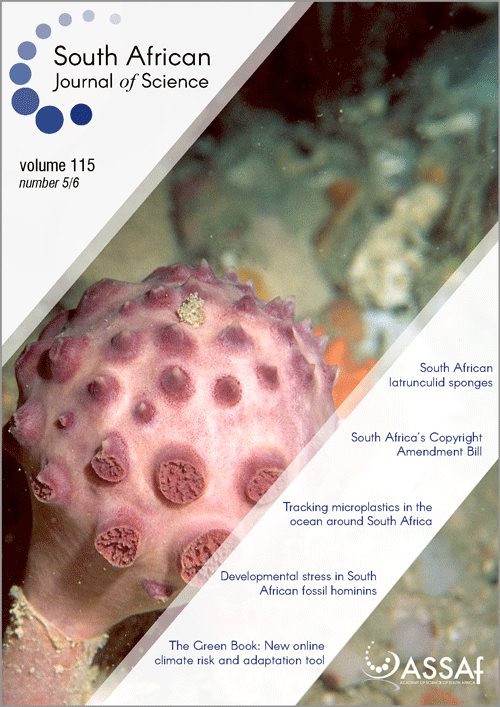Anthropogenic disturbances of natural ecohydrological processes in the Matlabas mountain mire, South Africa
DOI:
https://doi.org/10.17159/sajs.2019/5571Keywords:
ecohydrology, peatland hydrology, stable isotopes, radiocarbon datingAbstract
Matlabas is a mountain mire in Marakele National Park, located within the headwaters of the Limpopo River in South Africa. This mire consists of a complex of valley-bottom and seepage wetlands with small elevated peat domes. The occurrence of one decaying peat dome, which has burnt, and desiccated wetland areas with terrestrial vegetation has raised concerns. The aim of this study was to understand the mire features and water flows in order to identify the potential drivers causing wetland degradation. Wells and piezometers were installed to monitor the hydraulic head and collect water samples for analysis of ion composition, 18O and 2H stable isotope content, and δ13C and 14C isotope content for radiocarbon dating. Moreover, peat temperature profiles were measured and peat deposits were also dated using radiocarbon. Results indicate that the Matlabas mire developed in the lowest central-east side of the valley by paludification at the onset of the Holocene. During the Mid-Holocene, peat development was extended laterally by autogenic and allogenic processes. Three types of water flows driving peat development were identified – sheet flow, phreatic groundwater flow and deep groundwater flow – two of which are surface or near surface flows. The recent occurrence of decaying peat domes and desiccated wetland areas is possibly related to loss of exfiltrating deep groundwater flows that have resulted from drainage by the head-cut channels in the mire and interception of near surface water flow by an access road, respectively. Interventions should be undertaken to prevent further degradation of the mire.
Significance:
- This study is the first, as far as we are aware, on the ecohydrology of an inland mountainous mire in southern Africa.
- The results highlight the importance of the current wetland management (including rehabilitation) initiatives in South Africa.
- The integrative ecohydrological methods can be applied in other headwater wetlands in southern Africa.
Downloads
Published
Issue
Section
License

All articles are published under a Creative Commons Attribution 4.0 International Licence
Copyright is retained by the authors. Readers are welcome to reproduce, share and adapt the content without permission provided the source is attributed.
Disclaimer: The publisher and editors accept no responsibility for statements made by the authors
How to Cite
- Abstract 1012
- PDF 681
- EPUB 207
- XML 432
- Supplementary Material 258












.png)